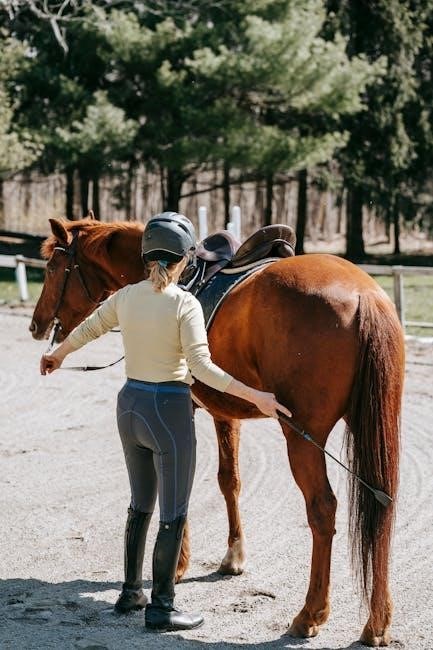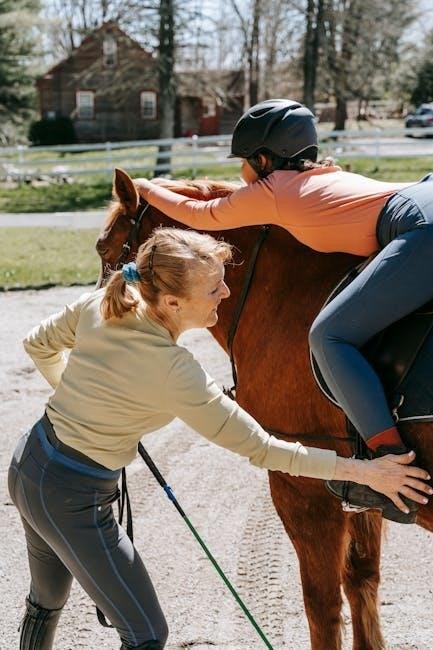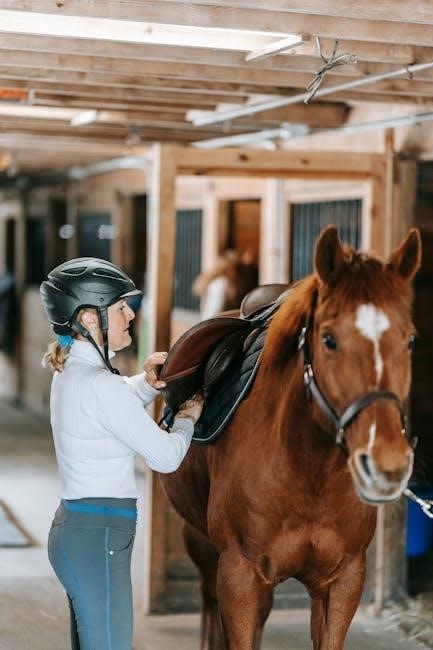Proper fit is crucial for safety and comfort․ Measure your head circumference, ensuring the helmet sits level․ Consider head shape and personal comfort․ A snug, not tight, fit is ideal․ Always refer to the manufacturer’s sizing chart for accurate selection․

Horse riding helmets are essential safety gear for equestrians, designed to protect the head from impact in case of a fall or accident․ Made from durable materials like polycarbonate or fiberglass, they absorb shock and distribute force to minimize injury․ Modern helmets are not only functional but also stylish, catering to various riding disciplines and personal preferences․ Whether for show jumping, dressage, or trail riding, a well-fitted helmet is a critical investment for every rider․
Reputable manufacturers, such as John Whitaker and Troxel, ensure their helmets meet rigorous safety standards, including SEI ASTM F1163-15 and VG1 certifications․ These standards guarantee the helmet’s ability to withstand high-impact forces․ Riders should replace helmets after significant impacts or every 5-10 years, depending on usage and wear․ Proper maintenance, such as cleaning and storing the helmet correctly, extends its lifespan and performance․
With advancements in technology, helmets now offer features like MIPS (Multi-Directional Impact Protection System) for enhanced safety․ Ventilation systems and adjustable fittings further improve comfort and customization․ While style and color options are plentiful, prioritizing safety and fit ensures optimal protection․ This guide will help you navigate the process of selecting the right helmet, starting with understanding the importance of proper fit and sizing․
Understanding the Importance of Proper Fit
A properly fitted horse riding helmet is vital for both safety and comfort․ A helmet that doesn’t fit correctly can shift during riding, leaving areas of the head unprotected or causing discomfort that distracts from performance․ Proper fit ensures the helmet stays securely in place, providing consistent protection across all riding conditions․

An ill-fitting helmet can lead to serious risks․ If too loose, it may not stay in position during a fall, failing to absorb impact effectively․ If too tight, it can cause discomfort, headaches, or even restrict blood flow․ Riders should avoid borrowing helmets, as they may not fit their unique head shape or size, compromising safety․

A well-fitted helmet enhances the riding experience by offering stability, comfort, and confidence․ It allows riders to focus on their technique and connection with the horse without distractions․ Proper fit also ensures the helmet’s ventilation and padding function as intended, maintaining comfort during long rides․

How to Measure Your Head for a Horse Riding Helmet
To ensure the best fit, measuring your head accurately is essential․ Use a flexible tape measure or a string to determine your head circumference․ Place the tape measure just above your eyebrows and ears, keeping it level and snug but not too tight․ This will give you the circumference measurement․
Record the measurement in inches or centimeters, as sizing charts for helmets are based on these values․ If using a string, mark the point where it overlaps, then measure the length with a ruler․ This method provides an accurate representation of your head size for helmet fitting․
Keep in mind that hairstyles or hats can slightly affect the fit, so measure without any headwear․ Some riders find it helpful to have someone assist for precision․ Once you have your measurement, compare it to the manufacturer’s sizing chart to select the correct helmet size․

Remember, proper measurement is the foundation of a well-fitting helmet, ensuring safety, comfort, and optimal performance during your ride․
Factors Influencing Helmet Size and Fit
Several factors can influence the size and fit of a horse riding helmet, making it essential to consider them during selection․ Head shape and size vary significantly among individuals, with some having rounder or more oval-shaped heads, which can affect how the helmet sits․ Hair volume, thickness, and style may also impact fit, as bulky hairstyles or ponytails can alter the measurement․ Additionally, manufacturer sizing can differ, so it’s crucial to refer to specific brand charts․
Weight and overall body composition play a role, as they can affect head circumference over time․ Riders who lose or gain weight may find their helmet fit changes slightly․ Personal comfort preferences, such as padding thickness or adjustability features, also influence the perceived fit․ Climate and weather conditions, like sweating during hot rides, can temporarily affect how the helmet feels․
These variables highlight the importance of trying helmets on and ensuring a snug yet comfortable fit․ Proper adjustment of straps and padding can further customize the fit to individual needs․ Ultimately, understanding these factors ensures a helmet that is both safe and comfortable for riding․
How to Choose the Right Helmet Size

Choosing the right helmet size involves a combination of accurate measurement, understanding manufacturer sizing, and personal fit preferences․ Begin by consulting the manufacturer’s size chart, as sizes can vary between brands․ Measure your head circumference using a flexible tape measure, ensuring it sits level and just above the eyebrows․ Compare this measurement to the chart to determine your size․
Consider the helmet’s adjustability features, such as adjustable dials or padding, which can fine-tune the fit․ Try the helmet on if possible, ensuring it feels snug but not overly tight․ The helmet should sit level on your head, with the front edge no more than one inch above your eyebrows․ Check for even contact around the head, avoiding pressure points․
Account for personal comfort preferences, such as padding thickness or ventilation needs․ If you plan to ride in varying conditions, look for helmets with removable or washable padding․ Ensure the chin strap fits securely under your chin and can be adjusted for a comfortable, safe fit․

Ultimately, the right size is one that balances safety, comfort, and personal preference, ensuring optimal protection and confidence while riding․
Ensuring a Proper Fit: Key Considerations
A proper fit is essential for both safety and comfort while riding․ A well-fitted helmet should sit level on your head, with the front edge resting just above your eyebrows․ The helmet should feel snug but not overly tight, ensuring even contact around your head without pressure points․ If the helmet shifts excessively or feels too loose, it may not provide adequate protection in the event of a fall․
Pay attention to the weight distribution of the helmet․ A properly fitted helmet should feel balanced, with no excessive weight concentrated in one area․ This prevents discomfort and fatigue during long rides․ Additionally, consider the padding and liner; they should be breathable and moisture-wicking to keep you comfortable in varying conditions․
Lastly, ensure the chin strap is adjusted correctly, providing a secure fit without digging into your skin․ A properly fitted helmet will stay in place even during sudden movements, offering peace of mind and confidence while riding․ Remember, a helmet that fits well is not only safer but also more enjoyable to wear․

Common Mistakes to Avoid When Sizing a Helmet
When sizing a horse riding helmet, there are several common mistakes to avoid to ensure optimal fit and safety․ One of the most frequent errors is relying solely on the size chart without considering individual head shape․ Helmets come in different fits, such as round or elongated, and failing to account for this can lead to discomfort or improper protection․
Another mistake is not testing the helmet’s fit with the chin strap securely fastened․ A loose chin strap can cause the helmet to shift during riding, compromising its protective capabilities․ Additionally, some riders neglect to check the helmet’s fit with their hair styled differently, such as in a ponytail, which can affect how the helmet sits on the head․
Overlooking the importance of padding and adjustability is another oversight․ While the helmet should fit snugly, it should not feel overly tight․ Ensuring the padding is breathable and the adjustable features are utilized can make a significant difference in comfort and safety․ Lastly, avoid assuming that all helmets fit the same way; always try on a helmet before purchasing to confirm the fit․
A properly fitted horse riding helmet is essential for both safety and comfort․ By following the guidelines outlined in this size guide, riders can ensure their helmet provides optimal protection and enhances their overall riding experience․ Remember, a helmet that fits well is not only a safety necessity but also a key factor in enjoying long, enjoyable rides․
Always prioritize proper fit over style or brand preferences․ Take the time to measure your head accurately and try on helmets to confirm the fit․ Adjustability features and padding can make a significant difference in comfort․ Additionally, consider the shape of your head and how it aligns with the helmet’s design․
Regularly check your helmet for wear and tear, as even minor damage can compromise its protective capabilities․ Stay informed about safety standards and updates in helmet technology to ensure you’re always riding with the best possible gear․ With the right helmet, you can focus on what matters most—enjoying the ride with confidence and peace of mind․
